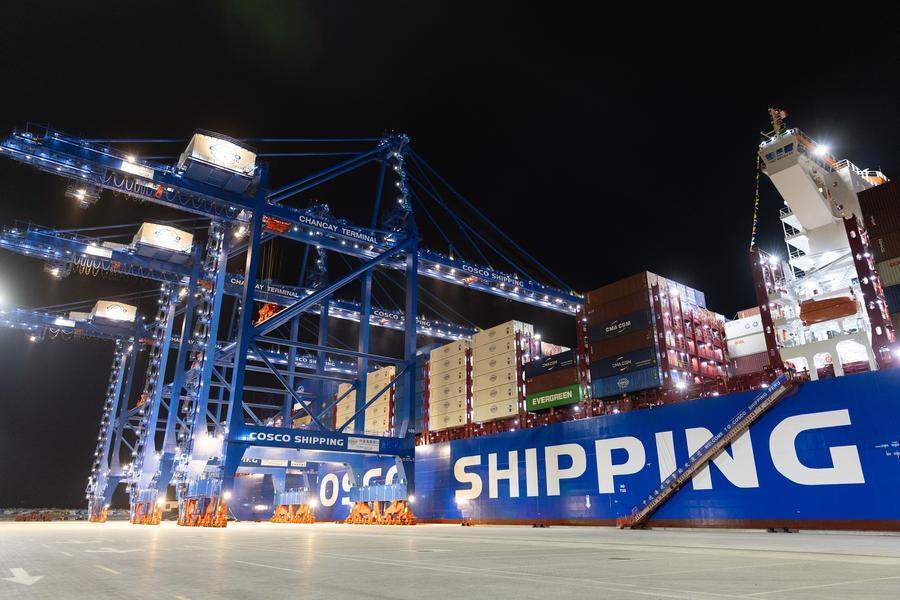
Representatives of overseas Chinese, local Chinese-funded enterprises and Chinese students in Brazil warmly welcome Chinese President Xi Jinping on the roadside while Xi's motorcade is on its way from the airport to the hotel in Brasilia, Brazil, November 19, 2024. [Photo/Xinhua]
Editor's note: CGTN's First Voice provides instant commentary on breaking stories. The column clarifies emerging issues and better defines the news agenda, offering a Chinese perspective on the latest global events.
China and Brazil announced on Wednesday to elevate their relations to further bolster the community with a shared future for a more just world and a more sustainable planet. The two countries signed more than 30 cooperation accords on agriculture, trade, technology, environmental protection and other areas.
The China-Brazil relationship is at its best in history, having not only improved the well-being of the people of the two countries but also defended the common interests of developing countries, enhanced the strength and voice of the Global South, and made outstanding contributions to world peace and stability, Chinese President Xi Jinping said during his state visit to Brazil.
Wednesday's decision reflects the cooperative nature of the China-Brazil relationship and the two countries' determination to jointly promote the common development of the world.
China has been Brazil's largest trading partner for 15 consecutive years and is a major source of foreign investment in Brazil. According to official statistics, China's annual imports from Brazil have stayed above $100 billion over the past three years.
Despite their geographical distance of approximately 18,800 kilometers, the two countries have a highly consistent position on development, security and global governance. Their coordination within the UN, G20, BRICS and other multilateral mechanisms has proven to be vital in building a more just and sustainable international system.
The elevation of ties has also demonstrated China's increasingly important role in Latin America. In recent years, China's presence in the region has been constantly expanding. According to a report recently released by the United Nations Economic Commission for Latin America and the Caribbean, China is not only an important trade partner but also the fastest-growing export market for Latin America and the Caribbean.
So far, 22 countries in Latin America have signed Belt and Road Initiative (BRI) cooperation documents with China. The Belo Monte Hydropower Plant ultra-high-voltage transmission line in Brazil, Argentina's Belgrano Cargas railway, Jamaica North-South Highway and other BRI projects have borne fruit, bringing concrete benefits to the region.

A view of Chancay Port in Peru, November 14, 2024. [Photo/Xinhua]
During his visit to Peru last week, Xi pledged to work with Peru to build a new land-sea corridor between China and Latin America with the Chancay Port as a starting point. As a flagship BRI project, the port is expected to cut the sea freight time from South America to Asia by half to 23 days and reduce logistics costs by at least 20 percent.
With its pursuit of common development, China is increasingly recognized and welcomed in Latin America. The Financial Times straight puts it as the "eclipse of the U.S. by China" in a region that Washington used to call its "backyard."
True, while China is investing in the $3.5 billion mega port that could generate $4.5 billion in yearly revenues for Peru and create over 8,000 direct jobs, the U.S. announced a $65 million assistance package to Peru, which includes the transfer of nine UH-60 Black Hawk helicopters over five years to strengthen the country's efforts against drug trafficking. Washington called it as a "new chapter" in the U.S.-Peru security partnership.
To further boost ties with Peru, the U.S. is also taking diesel-powered trains off the tracks in California to Lima, as the American city has switched to electric trains.
"It was such a striking contrast," Michael Shifter, adjunct professor at Georgetown University, was quoted by the Financial Times as saying. "You have this huge Chinese mega-port project that evoked Peru's history going back to the Incas and seeking greatness. And then what Biden delivered was some more helicopters for coca eradication. That seems completely outdated and stale," Shifter added.
Undeniably, Washington is "sincere" in fostering inclusive, sustainable and shared prosperity for Latin America and the rest of the world. To this end, the U.S. has launched the Americas Partnership for Economic Prosperity to deepen economic integration and tackle economic inequality across the region.
"But when it comes down to committing real resources, there is nothing there," said Shifter.
In contrast, China has been promoting common development through concrete actions, with the Chancay Port serving as a clear example of its sincerity in cooperating with Latin America. As the largest developing country, China remains committed to aligning BRI projects with the development strategies of other nations. The China-Latin America friendship has continuously expanded and deepened, and has become a key force in building a community with a shared future for mankind.

 中文
中文



